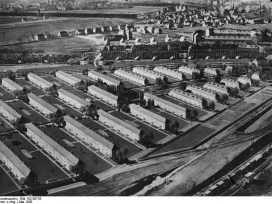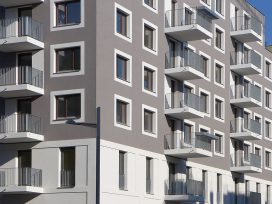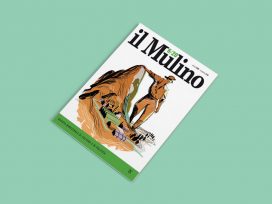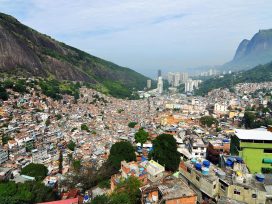Depending on who you ask, perceptions of Markthalle Neun in the Berlin district of Kreuzberg oscillate between two poles. Some describe it as a fascinating urban renewal project with an exceptional atmosphere. Others see it as one of the worst examples of the neighbourhood’s ongoing gentrification, which excludes large sections of the population. These antagonisms are negotiated in the discourse surrounding the market and its daily operations – what may be called its “assemblage”.
This article examines the coalescence of food and urbanism in public spaces such as food markets, and is nourished by an interest in urban everyday life, practices and ways of living together. Food “emerges as something with phenomenal power to transform not just landscapes, but political structures, public spaces, social relationships, cities”. Etched into the surface of the city, and recognizable in maps and plans, the influences of food become particularly clear when looking at the marketplaces that were formerly at the heart of the emerging city.
In the Markthalle Neun, it is possible to observe contemporary urban approaches to food provision, and to identify the actors, imaginaries and narratives that are making the market. A highly controversial space in the context of the wider neighbourhood, the site is currently at the centre of a social conflict, through which values and needs are negotiated as part of the market hall’s assemblage. Much of what we know and can learn about markets comes through doing (browsing, eating, buying, smelling, touching, etc.), and this doing “is also the making of the market [which takes place] through and with the market”. However, these lines of conflict greatly influence how and why people get involved with the market, if at all. By analysing the discourse surrounding the hall and the approach towards food culture that it stands for, I trace everyday struggles that hinder the hall’s inclusive potential. I also identify starting points for making the hall more accessible.

Markthalle Neun in Berlin Kreuzberg. Photo: Markthalle Neun.
Food markets in urban theory
Markets have played a key role in the emergence of cities. Historians, sociologists, anthropologists and other urban scholars all identify markets as important (public) spaces for social interaction, where “multiple forms of sociality are enacted” Representing “a significant public and social space for different groups in the locality […] for ‘rubbing along’ and for mediating differences”, markets are of great interest to studies attempting to counter the narrative of the decline of public space. Moreover, markets offer local communities potential “not just for local economic growth but also for people to mingle with each other and become accustomed to each other’s differences”. It is this “throwntogetherness” of market(place)s that “pose[s] in particular form the question of our living together”. Food and its capacity to encourage diverse sociable practices are central to this: “[I]t is the everyday interplay between people and food in and around food markets […] that is perhaps the most important way that food has been central to urban life, to ordinary city space and to urban social practices over time”.
However, marketplaces “are also domains of public discontent and dispute [where] conflicting interests, for example public benefit versus private entrepreneurship [are negotiated]”. In a passage that is reminiscent of the debates surrounding Markthalle Neun, Janssens and Sezer refer to city agendas that aspire “to profit from the strategic qualities of marketplaces”, thus hinting at a second theoretical layer of interest: the role of food and food places in urban regeneration and gentrification. As Sharon Zukin states, “during the past thirty years, food has emerged as the new ‘art’ in the urban cultural experience”. The rise of community gardening, artisan production, the striving for authenticity and an emergent foodie culture all bear witness to this contemporary enthusiasm for food, which has in turn provoked concerns about the role of food in the marketing of urban space and cities.
A third, closely related strand of interest in the relation between food and urbanism derives in large part from sociological thought on taste and distinction. Drawing upon Bourdieu’s forms of capital, Naccarato and LeBesco have argued that food – as culinary capital – can be a marker of social status supporting a middle-class identity assembled through food practices. This “culinary elitism” is also discussed by Johnston and Baumann, who examine the role of food in generating social status. Still, “while our taste in food continues to speak to our class position, this is not a simple correspondence between rarefied ‘fancy’ food for high-class people, but a more complex, omnivorous affair”.
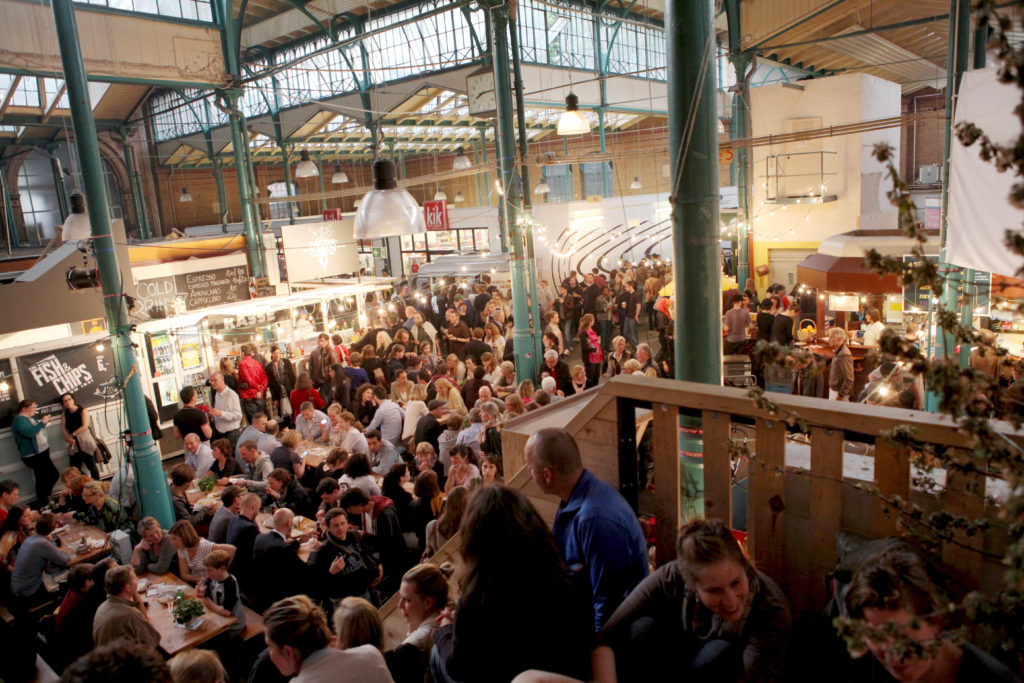
Street Food Thursday. Photo: Markthalle Neun.
Markthalle Neun
Markthalle Neun is one of three surviving historic market halls in Berlin. First opened in 1891, it was originally one of 14 halls supplying basic commodities and serving as the economic and social centres of their respective neighbourhoods. Facing serious decline after the 1980s as discounters moved in and changed its character, the hall was to be privatized and converted into a supermarket centre in 2009. These plans were overturned by a local residents initiative that pressured the city council to open the hall for cultural and interim use. Eventually, in a competitive tendering process based on quality criteria (with a focus on conceptual thinking, inclusive potential and a small-scale approach), the hall was sold to Markthalle Neun GmbH in 2011. Since then it has been gradually transformed, so that it now hosts a weekly farmer’s market on Tuesday, Friday and Saturday (just as it did previously), the Street Food Thursday and other, less frequent, monothematic markets. One of the discount stores (Aldi), also remains in the hall.
This eclectic mix of markets, facilities and events stems from an interplay of conceptual and economic deliberations. On the one hand, in promoting an alternative food economy, the operators are steering a development process that emphasizes the significance of slowly-established structures, small-scale food production and local seasonal produce. On the other hand, popular events – attracting many people and much media attention – are intended to ensure the financial feasibility of the venture. Furthermore, with permanent fixtures such as a bakery, an in-house craft-brewery, a fish and meat smokehouse, a café and a canteen, the hall seeks to function as a site for the manufacture of food, and to honour one of the aims stated in its concept – to bring food and its production back into an urban environment.
As a case study, Markthalle Neun is particularly intriguing for researchers interested in urban space, food and everyday practices, since it serves as an example of a venue where constructed everyday life is situated between the ordinary (daily life, market) and the extraordinary (alternative ways of living, events). This scenario takes shape amid a variety of associations that are facilitated in, around and by the market, making for a highly controversial space.
Tracing discourse
A range of different actors and users project demands and desires onto the market, creating a high potential for conflict. Also, a certain language has crept into the general discourse that makes it hard to reflect on the nuances of stances taken: catchphrases such as Hall for All, the narrative of the green border that divides the hall in two, but also repeated comparisons with other districts, which partially disguise the diversity of opinions, make the conflict appear as if it had two unified parties opposing one other. Rooted in personal values and connections to the hall, individual opinions on the market range from complete rejection, through subliminal fears about further gentrification that might well change the neighbourhood beyond recognition, to concessions on the part of residents who appreciate attempts to keep the hall open and whose view of the market is based on its overall atmosphere. Given that discourse is one of the elements that constitute the social, it is essential for an account of the market hall and its making to unravel the conflicting aspects of this assemblage.
Noise and pollution
Noise and security issues surrounding markets were one of the main reasons for the City of Berlin’s decision in the 19th century to relocate the busy markets inside halls. Today, with the revival of the hall, the market’s daily operations do not go unnoticed in its vicinity: the hall is located in the midst of a densely populated residential area. A second problem is the increase in rubbish on the streets around the hall, with broken glass bottles creating the most concern. Complaints focus on Thursday nights, when Street Food Thursday attracts thousands of people, substantially increasing the overall number of people out and about on the neighbourhood’s streets.
This has led to the market hall implementing new practices to reduce noise and waste. Upon leaving the venue on a Thursday night, people pass a shopping cart designated as the collection point for bottles – doormen ensure that bottles bought inside the hall are not carried outside. Vendors are also considering options to reduce waste. While some of them – due to the size and permanence of their stall – are able to serve food on reusable plates that are collected on a tray next to the canteen, others try to operate more sustainably by using disposable tableware made of palm leaves. Further ideas were developed as part of a neighbourhood workshop introduced after the first Stadt Land Food Festival took place in the streets surrounding the market. While the first meetings attracted about 50 residents, it transpired that most of them were not interested in long-term processes but simply wanted to voice their complaints and frustration about the overall approach at the market. Today, the workshop consists of only a few members. Still, participants continue to work on solutions to the conflict and have produced two posters illustrating what they do not want to see on the streets of their neighbourhood. The posters are now used by a vast number of businesses and institutions in the vicinity.

Unwanted nuisance and maintaining respect. Photo: Daniel Wiesmann.
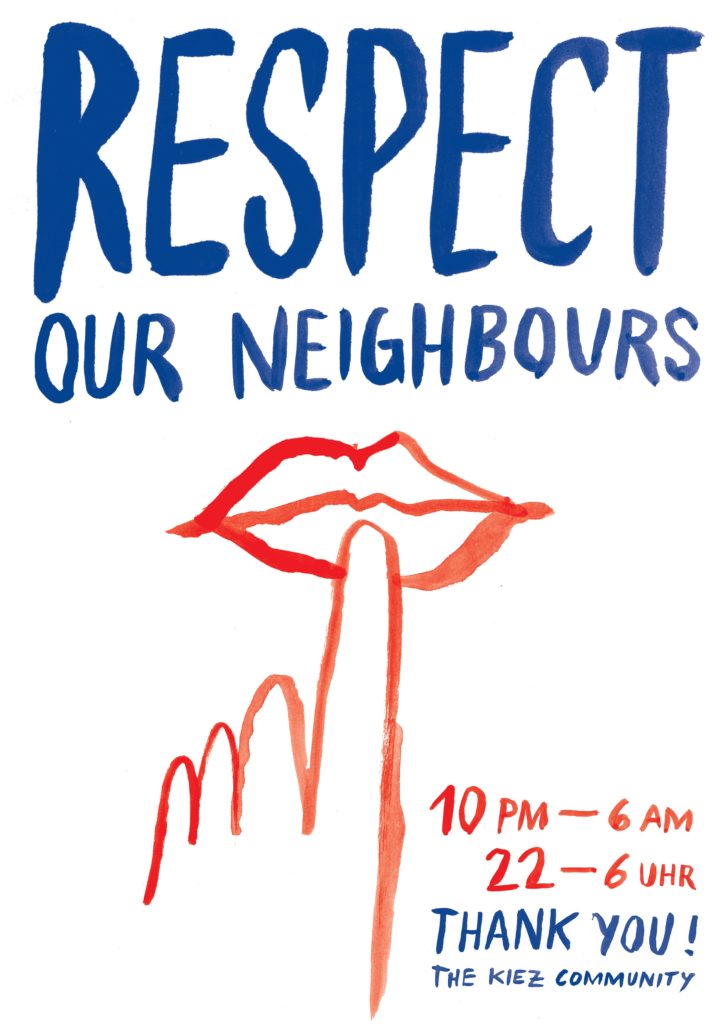
Unwanted nuisance and maintaining respect. Photo: Daniel Wiesmann.
All this adds new entities to the assemblage of the market (shopping carts, palm leaves, doormen, posters). In connection with different practices, they become part of a solution-oriented discourse seeking to manage the conflicts that characterize its existence. However, opinions amongst residents are divided. Acknowledging the idea behind the posters and workshop as such, they criticize the general process of communication: “They [the operators] make an effort, but […] only if it is causing problems. I think this is the point being noticed from outside.” This illustrates another layer to the conflict: despite the action taken by the hall’s operators, many people living in its vicinity attest to a lack of engagement from the operators. Reading this as indifference to their feedback and involvement, some residents dismiss the concept of the hall, which in some cases results in a complete boycott of the market.
“I know quality has its price, but…”
Taken from a conversation with a resident of the neighbourhood surrounding the market hall, this fragment reveals the main reason for criticism: the prices of the food on offer are too high for many people living in Kreuzberg seeking affordable products. Germany’s food industry is dominated by an intense price war, resulting in knockdown prices that are sometimes even lower than the production costs of foodstuffs. In Germany, a fairly low proportion of average household income is spent on food each month. In this neighbourhood, the average amount spent on food per head comes to a mere €155 per month proving that cost-cutting practices to be part of everyday life for many residents of Kreuzberg. Their demand for affordable food is predominantly satisfied by discount stores. The contrast between a low income neighbourhood and a hall that – according to its operators – aims to offer “a serious alternative to about 90 per cent of the German food industry”, results in an ongoing controversy, particularly about pricing. Both sides use the variable of income in arguing their case, with residents looking to meet their own (and their families’) food needs and operators looking to promote a democratic and fair price. While some residents acknowledge that “non-industrial [food] production involve[s] higher costs”, and that maintaining a landmark building “comes at a high price”, the conflict is inextricably woven into the assemblage of the market.
Of hipsters, foodies and tourists
Discussions about pricing are also connected to narratives concerning the kind of people who enjoy the market’s food, which seems not to appeal to the appetite of the area’s average resident. Visitors to the market are categorized into three groups that are the subject of recurring criticism: hipsters, foodies and tourists. These are not clear-cut categories, but they are still used to negotiate issues surrounding inclusion and boundaries in relation to the assemblage.
The notion of the hipster, referred to by almost everyone I talked to, is not clearly defined and “seems to be used as if its meaning was universally fixed and transparent, while in reality its meaning is opaque and fluid”. Hipsters have become associated with gentrification processes that change the material infrastructure of a city into a “hipster infrastructure”. In the context of the market, hostility towards hipsters stems from an underlying fear of further gentrification and displacement, and a perception of the hall as one of those pieces of hipster infrastructure that has lost its function as a neighbourhood space.
Combined with the notion of the foodie, this deepens the roots of suspicion towards the hall. Again, this speaks of processes of social exclusion through elitism. Being a foodie is seen as a privilege that cannot be enjoyed without adequate economic and cultural capital. It is certainly interesting to note that the notion of a foodie focuses on the type of consumer – not necessarily the type of food. The relation to food and food culture is overshadowed by this meta-narrative, which partially inhibits residents’ serious engagement with the food offered in the market, keeping them from entering a hall where they feel they do not belong.
The third category, the tourist, is more complicated, since it not a theoretical construct. Tourists, thousands of whom visit the neighbourhood each year, are very much a reality. Still, distinguishing strictly between tourists and other categories (such as migrants, refugees, multilocals) remains problematic in the public debate about the touristification of Berlin. In the case of the market hall, this ambiguity finds expression in generalizations such as “they all fly in on Thursdays” and “no one even speaks German”. The (city-wide) discussion about tourism certainly influences perceptions of the hall and its operations, particularly as travel guides and blogs recommend a visit, thus raising the site’s profile yet further.
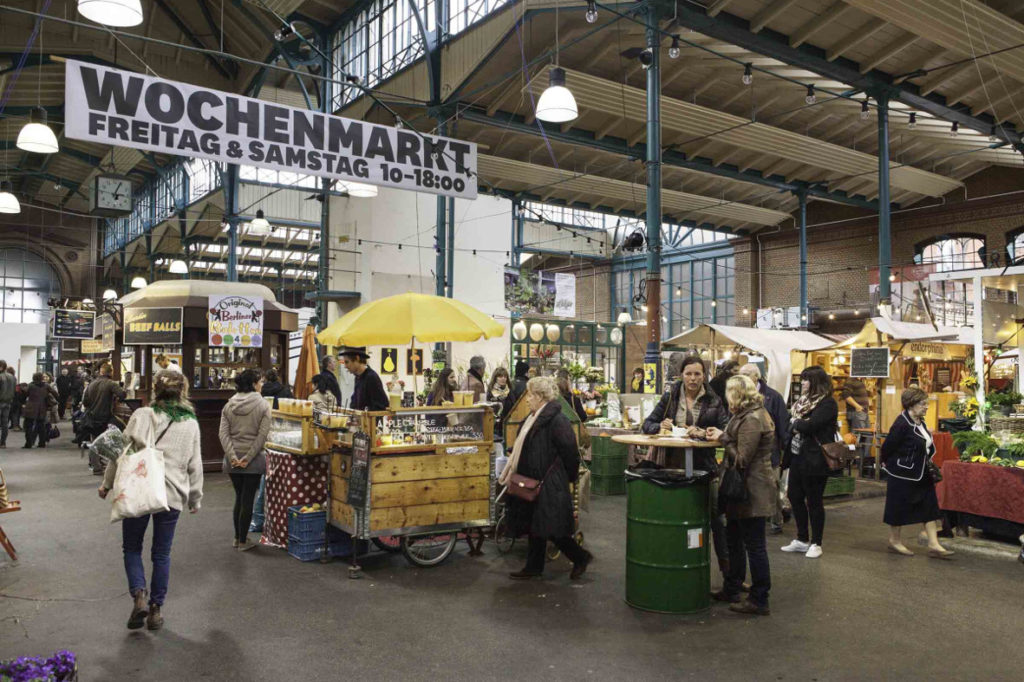
Wochenmarkt. Photo: Markthalle Neun.
Reconciling differences
Most of the problems emerging from the market’s operations (noise, pollution, and conceptual strategies that clash with the surrounding neighbourhood’s socio-spatial needs) are inextricably interwoven into the market’s existence. The hall has to do everything it can as a private venture to remain financially feasible. At the same time, the concept of a space whose aim is to engage with quality food clashes with the low socio-economic status of many of the area’s residents. This results in conflicting spatial needs and desires being projected onto the hall. But does the market fulfil its envisaged function as a (semi-)public space that facilitates exchange and participation in the social life of the neighbourhood? The hall offers pioneering approaches to the sustainable provision of quality food, but how inclusive/exclusive can such a contemporary market be? How are we to acknowledge the “plethora of fleeting forms of ‘rubbing along’, connecting, lingering, and taking pleasure in a shared space”? Although sometimes ephemeral, these practices performed as part of the market’s assemblage point to opportunities for inclusiveness and the capacity “to dissolve some of the predictable boundaries and divisions and open up new possibilities for sociality and engagement in everyday public space”.
In the case of Markthalle Neun, most of these activities take on subtle forms of sociality (dwelling, short exchanges of information/knowledge/words, sitting side-by-side). Still, with an active and engaged community of traders providing part of the social life of the assemblage, opportunities for sociality regularly arise. While this points to emerging possibilities for an “enhanced social inclusiveness” further analysis indicates that, in order to consolidate upon these possibilities, discursive mediation is needed to soften conflicts and barriers. Clarifying the conceptual approach and unpacking the “black box” of the market could reduce uncertainty and create opportunities to invite more locals into the hall. It seems unclear who could initiate such a mediation: the operators of the hall, fed-up neighbours, market vendors, an external mediator, the neighbourhood workshop?
What is clear, however, is that the mediation must take the form of a dialogue that acknowledges the needs, desires and fears projected on to the hall by neighbours operators and vendors alike. Given that an assemblage approach has a pronounced temporal perspective, only a longer-term ethnography of the market assemblage can reveal whether convivial possibilities could be consolidated upon, as the operators would hope, through “pursuing the concept consequently and honestly, bringing back the people and thus establishing authenticity and credibility”.
